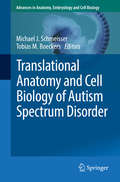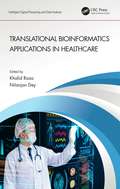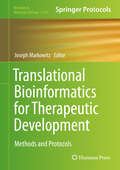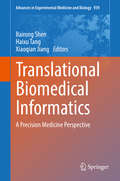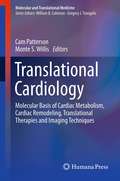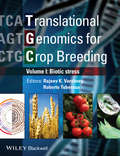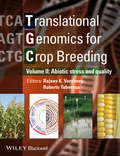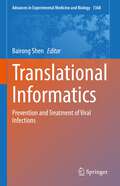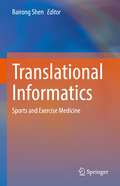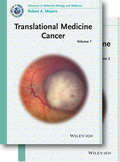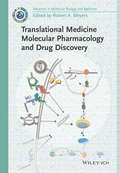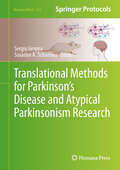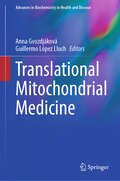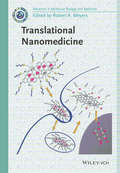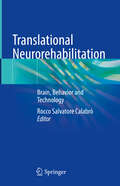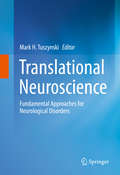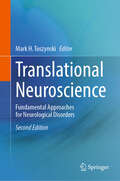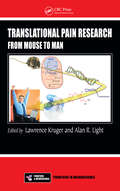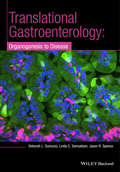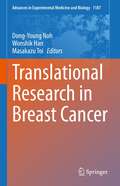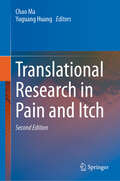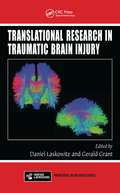- Table View
- List View
Translational Anatomy and Cell Biology of Autism Spectrum Disorder
by Michael J. Schmeisser Tobias M. BoeckersAutism spectrum disorder (ASD) affects approximately 1 % of the human population and is characterized by a core symptomatology including deficits in social interaction and repetitive patterns of behaviour plus various co-morbidities. Although a lot of progress has been made to uncover underlying causes and mechanisms throughout the last decade, we are still at the very beginning to understand this enormously complex neurodevelopmental condition. This special volume is focused on translational anatomy and cell biology of ASD. International experts from the field including several members of the EU-AIMS initiative launched by the European Union to develop novel treatments for ASD have contributed chapters on several topics covering all crucial aspects of translational ASD research with a special emphasis on ASD model systems including stem cells and animals. Primary objective is to clarify how anatomical and cell biological phenotypes of ASD will help to translate basic mechanisms to clinical practice and to efficiently treat affected individuals in the near future.
Translational Bioinformatics Applications in Healthcare (Intelligent Signal Processing and Data Analysis)
by Nilanjan Dey Khalid RazaTranslational bioinformatics (TBI) involves development of storage, analytics, and advanced computational methods to harvest knowledge from voluminous biomedical and genomic data into 4P healthcare (proactive, predictive, preventive, and participatory). Translational Bioinformatics Applications in Healthcare offers a detailed overview on concepts of TBI, biological and clinical databases, clinical informatics, and pertinent real-case applications. It further illustrates recent advancements, tools, techniques, and applications of TBI in healthcare, including Internet of Things (IoT) potential, toxin databases, medical image analysis and telemedicine applications, analytics of COVID-19 CT images, viroinformatics and viral diseases, and COVID-19–related research. Covers recent technologies such as Blockchain, IoT, and Big data analytics in bioinformatics Presents the role of translational bioinformatic methods in the field of viroinformatics, as well as in drug development and repurposing Includes translational healthcare and NGS for clinical applications Illustrates translational medicine systems and their applications in better healthcare Explores medical image analysis with focus on CT images and novel coronavirus disease detection Aimed at researchers and graduate students in computational biology, data mining and knowledge discovery, algorithms and complexity, and interdisciplinary fields of studies, including bioinformatics, health-informatics, biostatistics, biomedical engineering, and viroinformatics. Khalid Raza is an Assistant Professor, the Department of Computer Science, Jamia Millia Islamia (Central University), New Delhi. His research interests include translational bioinformatics, computational intelligence methods and its applications in bioinformatics, viroinformatics, and health informatics. Nilanjan Dey is an Associate Professor, the Department of Computer Science and Engineering, JIS University, Kolkata, India. His research interests include medical imaging, machine learning, computer-aided diagnosis, and data mining.
Translational Bioinformatics for Therapeutic Development (Methods in Molecular Biology #2194)
by Joseph MarkowitzThis volume introduces Translational Bioinformatics as it relates to therapeutic development, and addresses the techniques needed to effectively translate large data sets to relevant biological networks. Chapters detail clinical informatics infrastructure, and leverage pathology, immunology, pharmacology, genomic, proteomic, and metabolomic informatics approaches. Written in the highly successful Methods in Molecular Biology series format, chapters include introductions to their respective topics, application details for both the expert and non-expert reader, and tips on troubleshooting and avoiding known pitfalls. Authoritative and practical, Translational Bioinformatics for Therapeutic Development: Methods and Protocols aims to ensure success in the study of Translational Bioinformatics.
Translational Biomedical Informatics
by Bairong Shen Haixu Tang Xiaoqian JiangThis book introduces readers to essential methods and applications in translational biomedical informatics, which include biomedical big data, cloud computing and algorithms for understanding omics data, imaging data, electronic health records and public health data. The storage, retrieval, mining and knowledge discovery of biomedical big data will be among the key challenges for future translational research. The paradigm for precision medicine and healthcare needs to integratively analyze not only the data at the same level - e. g. different omics data at the molecular level - but also data from different levels - the molecular, cellular, tissue, clinical and public health level. This book discusses the following major aspects: the structure of cross-level data; clinical patient information and its shareability; and standardization and privacy. It offers a valuable guide for all biologists, biomedical informaticians and clinicians with an interest in Precision Medicine Informatics.
Translational Cardiology
by Cam Patterson Monte S. WillisTranslational Cardiology: Molecular Basis of Cardiac Metabolism, Cardiac Remodeling, Translational Therapies and Imaging Techniques provides an up-to-date introduction to the role circadian rhythms, cardiac plasticity, and mechanotransduction play in the heart, while at the same time introducing new developments in cellular, viral, and non-biologic therapies that are in the process of being developed. Importantly, the focus of this book is on topics that, due to their novelty, are largely not covered in the other major textbooks. A special emphasis is placed on the molecular basis of cardiac metabolism, new concepts in cardiac remodeling, and translational therapies and imaging techniques currently under development for clinical use. The chapters are written by experts from diverse clinical and biomedical research backgrounds. Translational Cardiology: Molecular Basis of Cardiac Metabolism, Cardiac Remodeling, Translational Therapies and Imaging Techniques simplifies the complexity of the molecular basis of disease by focusing on patient-oriented disease mechanisms and therapies and is of great value to a broad audience including physicians (e.g. cardiologists, cardiovascular surgeons, pathologists) as well as translational biomedical researchers in a wide range of disciplines.
Translational Genomics for Crop Breeding: Biotic Stress
by Roberto Tuberosa Rajeev K. VarshneyGenomic Applications for Crop Breeding: Biotic Stress is the first of two volumes looking at the latest advances in genomic applications to crop breeding. This volume focuses on genomic-assisted advances for improving economically important crops against biotic stressors, such as viruses, fungi, nematodes, and bacteria. Looking at key advances in crops such as rice, barley, wheat, and potato amongst others, Genomic Applications for Crop Breeding: Biotic Stress will be an essential reference for crop scientists, geneticists, breeders, industry personnel and advanced students in the field.
Translational Genomics for Crop Breeding: Improvement for Abiotic Stress, Quality and Yield Improvement
by Roberto Tuberosa Rajeev K. VarshneyGenomic Applications for Crop Breeding: Abiotic Stress, Quality and Yield Improvement is the second of two volumes looking at the latest advances in genomic applications to crop breeding. This volume focuses on advances improving crop resistance to abiotic stresses such as extreme heat, drought, flooding as well as advances made in quality and yield improvement. Chapters examine advances in such key crops as rice, maize, and sugarcane, among others. Genomic Applications for Crop Breeding: Abiotic Stress, Quality and Yield Improvement complements the earlier volume on biotic stressors and will be an essential purchase for those interested in crop science and food production.
Translational Informatics: Prevention and Treatment of Viral Infections (Advances in Experimental Medicine and Biology #1368)
by Bairong ShenThis book introduces the translational informatics applied to most aspects of virus infection, including tracking of virus origin, detection and prevention of infection, drug discovery, and vaccine design as well as smart city-level monitoring and controlling of the virus epidemic by government. It covers the informatics for data mining and modelling at molecular, tissue/organ, individual, and population levels. The informatics for immunological mechanisms and the personalized prediction and treatment of infected patients are also summarized. The perspectives on the application of artificial intelligence to the prevention of virus outbreaks are also given. This book will be helpful to readers who are interested in prevention of virus infection, biomedical informatics, and artificial intelligence in medicine and healthcare.
Translational Informatics: Sports and Exercise Medicine (Advances In Experimental Medicine And Biology Ser. #1005)
by Bairong ShenThe book provides readers the informatics and data-driven models for the discovery of personalized excise prescriptions applied to different cases. Overdiagnosis or over-treatment often happened since the complex interaction among the lifestyle, genetic, and environmental factors. Sports and exercise are reported efficient to prevent or reduce the risk of diseases, but the interactions between sports/exercise and disease are personalized and complex. Translational informatics is a powerful paradigm and it promotes the transfer of big data, knowledge and models to the precision application of sports to prevent diseases. Sports and exercise may have different effects on diverse diseases including cancers, neurodegenerative disease, and cardiovascular diseases, etc. This book covers many modern informatics models such as ontologies, knowledge graphs, blockchain, participatory medicine, semantic artificial intelligence, big data modeling, and so on. It also describes the challenges for the sports and exercise medical data sharing and standardization, the privacy protection of data as well as the integration of data from genomic level to physiological phenotype level. This book will be helpful to the readers who are interesting in sports and exercise medicine, healthcare, big data modeling, artificial intelligence in medicine and healthcare.
Translational Medicine 2 Volume Set: Cancer
by Robert A. MeyersThe first complete overview of progress in the field. The two volumes contain selected articles from the prestigious online Encyclopedia of Molecular Cell Biology and Molecular Medicine, fully updated and enriched with numerous new contributions from many eminent scientists. Divided into three parts, the first gives a thorough introduction to cancer biology, while Part Two covers therapeutic approaches for all major forms of cancer, and the third part deals with cancer diagnostics. The result is a one-stop resource for advanced students, postdoctoral researchers and start-up companies.
Translational Medicine: Molecular Pharmacology and Drug Discovery (Current Topics from the Encyclopedia of Molecular Cell Biology and Molecular Medicine)
by Robert A. MeyersThis reference work gives a compete overview of the different stages of drug development using a translational approach. The book is structured in different parts, following the different stages in drug development. Almost half of the work is dedicated to core of drug discovery using a translational approach, the identification of appropriate targets and screening methods for the identification of compounds interacting with these targets. The rest of book covers the whole downstream pipeline after the identification of lead compounds, such as bioavailability issues, identification of appropriate drug delivery venues, production and scaling issues and preclinical trials. As has been the case with other works in the encyclopedia, the book is made up of long, comprehensive and authoritative chapters, written by outstanding researchers in the field.
Translational Methods for Parkinson’s Disease and Atypical Parkinsonism Research (Neuromethods #213)
by Susanne A. Schneider Sergiu GroppaThis volume provides readers with an overview of translational paths that can be used to study the pathophysiology of Parkinson’s Disease and atypical parkinsonism, including molecular processes, tissue integrity, and cerebral networks during inflammatory and neurodegenerative processes. The chapters in this book are organized into three parts and cover topics such as new developments of cerebral circuit characterizations and computational neuroscience for the description of the brain’s transition through disease stages; static and dynamic systemic changes with clinical and functional outcome measures; and atypical syndromes such as neurodegenerations, immunological processes, and progressive disease states. In the Neuromethods series style, chapters include the kind of detail and key advice from the specialists needed to get successful results in your laboratory. Cutting-edge and comprehensive, Translational Methods for Parkinson’s Disease and Atypical Parkinsonism Research is a valuable resource that provides a new perspective on the disease from a scientific and clinical point of view, and highlights the importance of available and emerging technologies.
Translational Mitochondrial Medicine (Advances in Biochemistry in Health and Disease #32)
by Guillermo López Lluch Anna GvozdjákováTranslational mitochondrial medicine applies the knowledge of experimental medicine in clinical practice, it is a prospective direction of the development of mitochondrial medicine. The monograph "Translational Mitochondrial Medicine" was created on the basis of rapidly developing new information about mitochondrial diseases and their disorders, is a revised and supplemented edition of the monographs: "Mitochondrial Medicine", ed. A. Gvozdjáková, Springer, 2008 and "Recent Advances in Mitochondrial Medicine and Coenzyme Q10", eds. A. Gvozdjáková, G. Cornélissen, RB Singh, NOVA Science, USA, 2018. The monograph was created as part of the book series "Advances in biochemistry in health and disease", edited by prof. Naranjan Dhalla of Winnipeg, for which we are grateful. The book"Translational Mitochondrial Medicine" contributes to the elucidation of the pathobiochemical mechanisms of various diseases, provides current information on the prospective application of the latest diagnostic approaches and targeted therapy of mitochondrial diseases. Perspective mtDNA diagnostic methods include new technologies based on NGS (Next Generation Sequencing) to identify new genes associated with mitochondrial diseases. With the help of the high resolution respirometry method (HRR), it is possible to record even the most subtle deviations of the bioenergetics of mitochondria in blood cells, it contributes to the monitoring of the used daily doses of drugs in patients with various diseases. Determination of the endogenous level of coenzyme Q10 (CoQ10) in platelets is a key method to improve the diagnosis and targeted therapy of damaged mitochondrial bioenergetics. Perspective therapeutic strategies for damaged mitochondria include mitochondrial transplantation, plasma therapy, mitochondrial nanotherapy, weight reduction in obesity, spa rehabilitation, the influence of molecular hydrogen and oxygen therapy. Targeted therapeutic methods for dysfunctional mitochondria and CoQ10 deficiency include supplementation with CoQ10, antioxidants and vitamins. This volume is intended for researchers and physicians looking for new prospective diagnostic approaches and targeted therapies for dysfunctional mitochondria in their patients.
Translational Nanomedicine (Current Topics from the Encyclopedia of Molecular Cell Biology and Molecular Medicine)
by Robert A. MeyersThe largest high-level encyclopedia on molecular medicine is now publishing a topical volume on Nanomedicine. The long awaited volume gives a comprehensive overview on nanomaterials in drug delivery, imaging and as therapeutics.
Translational Neurorehabilitation: Brain, Behavior and Technology
by Rocco Salvatore CalabròThis book focuses on rehabilitation demonstrating how translational research may help clinicians in boosting neural plasticity and functional recovery. Translational Neurorehabilitation is a new interesting field that seeks to produce more meaningful, applicable rehabilitation results that directly enhance human health, performance and quality of life. As neurological diseases increase with age and people who survive a brain injury are rising, thanks to the improvement of intensive acute care, the need to appeal to neurorehabilitation will double in the next few years. Motor, cognitive and behavior approaches have changed over the years and novel tools to treat brain and spinal cord injury should be validated before translating them into clinical practice. The book is aimed to expand the current understanding of brain function and disease by evaluating preclinical and clinical trials on neural plasticity and functional recovery after nervous system disorders. Also, it disseminates the knowledge coming from novel therapies, including advanced robotic and ICT-based applications. The book will be of interest to neuroscientists, physiatrists, neural engineers, and clinical neurologists.
Translational Neuroscience
by Mark H. TuszynskiTranslational Neuroscience offers a far-reaching and insightful series of perspectives on the effort to bring potentially revolutionary new classes of therapies to the clinic, thereby transforming the treatment of human nervous system disorders. Great advances in the fields of basic neuroscience, molecular biology, genomics, gene therapy, cell therapy, stem cell biology, information technology, neuro devices, rehabilitation and others over the last 20 years have generated unprecedented opportunities to treat heretofore untreatable disorders of the nervous system. This book provides a wide-ranging yet detailed sample of many of these efforts, together with the methods for pursuing clinical translation and assessing clinical outcomes. Among the topics covered are Alzheimer's disease, Parkinson's disease, stroke, multiple sclerosis, epilepsy, motor neuron disease, pain, inborn errors of metabolism, brain tumors, spinal cord injury, neuroprosthetics, rehabilitation and clinical trial design/consideration. Translational Neuroscience is aimed at basic neuroscientists, translational neuroscientists and clinicians who seek to gain a perspective on the nature and promise of translational therapies in the current era. Both students and established professionals will benefit from the content.
Translational Neuroscience:
by Michael Williams James E. Barrett Joseph T. CoyleTranslational neuroscience is at the heart of clinical advancement in the fields of psychiatry, neurology and neurodevelopmental disorders. Written and edited by leading scientists and clinicians, this is a comprehensive and authoritative analysis of this emerging strategy for developing more effective treatments for brain disorders. Introductory chapters bring together perspectives from both academia and industry, while subsequent sections focus on disease groups, including bipolar disorder and depression, attention deficit hyperactivity disorder, substance abuse, autism, Alzheimer's disease, pain, epilepsy, Parkinson's disease and multiple sclerosis. Each section includes topical introductory and summary chapters, providing an overview and synthesis of the field. Translational Neuroscience: Applications in Neurology, Psychiatry, and Neurodevelopmental Disorders is an important text for clinicians, scientists and students in academic settings, government agencies and industry, as well as those working in the fields of public health and the behavioural sciences.
Translational Neuroscience: Fundamental Approaches for Neurological Disorders
by Mark H. TuszynskiThe second edition of Translational Neuroscience offers wide-ranging and insightful perspectives on the effort to bring potentially revolutionary new classes of therapies to the clinic, thereby transforming the treatment of human nervous system disorders. Great advances in the fields of basic neuroscience, molecular biology, genomics, gene therapy, cell therapy, stem cell biology, information technology, rehabilitation, and others over the last 20 years have generated unprecedented opportunities to treat heretofore untreatable disorders of the nervous system. This book provides detailed coverage of these efforts, together with the methods for pursuing clinical translation and assessing clinical outcomes. All of the first edition chapters have been extensively updated, and many new chapters have been added, including brain-machine interface, gene therapy, anti-sense oligonucleotides, and CRISPR. Among the many other topics covered are Alzheimer’s disease, Parkinson’s disease, stroke, multiple sclerosis, epilepsy, motor neuron disease, pain, inborn errors of metabolism, brain tumors, spinal cord injury, neuroprosthetics, rehabilitation, and clinical trial design/consideration.
Translational Pain Research: From Mouse to Man (Frontiers in Neuroscience)
by Lawrence Kruger Alan R. LightOne of the Most Rapidly Advancing Fields in Modern Neuroscience The success of molecular biology and the new tools derived from molecular genetics have revolutionized pain research and its translation to therapeutic effectiveness. Bringing together recent advances in modern neuroscience regarding genetic studies in mice and humans and the practical
Translational Research and Discovery in Gastroenterology
by Linda C. Samuelson Deborah L. Gumucio Jason R. Spencepathways of GI organ development alongside clinical chapters examining organ-based diseases, closing the gap between the bench and the clinic. * Derivative organs - esophagus, stomach, pylorus, small intestine, colon, liver, and pancreas -as well as tissues such as serosa and enteric nervous system that are common to multiple GI organs. * Chapters detailing the use of model organisms - Drosophila, sea urchin, zebrafish, C. elegans, Xenopus - for basic discovery studies are included. * Chapters on GI stem cells and the potential for tissue engineering of the GI organs provide a view to the future of research and therapy in these organs.
Translational Research and Onco-Omics Applications in the Era of Cancer Personal Genomics (Advances in Experimental Medicine and Biology #1168)
by Erika Ruiz-Garcia Horacio Astudillo-de la VegaBeing a complex disease that affects millions of people world over, cancer research has assumed great significance. Translational cancer research transforms scientific discoveries in the laboratory into clinical application to reduce incidence of cancer, morbidity and mortality. On the other hand, personalized medicine in cancer is the concept that selection of a treatment should be tailored according to the individual patient’s specific genomic characteristics, including mutations, chromosomal aberrations, protein interactions, and SNPs, and even more, taking into account the inmume system, the metabolism and maybe in the next future also the microbiome.
Translational Research in Breast Cancer (Advances in Experimental Medicine and Biology #1187)
by Masakazu Toi Dong-Young Noh Wonshik HanThis book describes recent advances in translational research in breast cancer and presents emerging applications of this research that promise to have meaningful impacts on diagnosis and treatment. It introduces ideas and materials derived from the clinic that have been brought to "the bench" for basic research, as well as findings that have been applied back to "the bedside". Detailed attention is devoted to breast cancer biology and cell signaling pathways and to cancer stem cell and tumor heterogeneity in breast cancer. Various patient-derived research models are discussed, and a further focus is the role of biomarkers in precision medicine for breast cancer patients. Next-generation clinical research receives detailed attention, addressing the increasingly important role of big data in breast cancer research and a wide range of other emerging developments. An entire section is also devoted to the management of women with high-risk breast cancer. Translational Research in Breast Cancer will help clinicians and scientists to optimize their collaboration in order to achieve the common goal of conquering breast cancer.
Translational Research in Environmental and Occupational Stress
by Shashi Bala Singh Nanduri R. Prabhakar Srinivas N. PentyalaCutting edge technologies can propel a simple finding in basic science to a concept that can be of immense value to the society. While applying novel techniques to unravel the mysteries of biological processes, an offshoot of applied branch emerged. This field, which is now widely referred to as Translational Research utilizes basic science findings and translates these findings into innovative concepts for the benefit of mankind. This branch of science has evolved into a multidisciplinary juggernaut encompassing all known fields of science as varied as biomedicine, environment, law, economics, sociology, etc. With the ever increasing interest in this branch and the dreams and aspirations that this field can bring, basic science researchers are now taking a bold step into this new realm, merging different fields of knowledge to come up with novel inventions. This book "Translational research in environmental and occupational stress" provides and insight into the research that led to discoveries, inventions and development of novel technologies which will have a tremendous impact on the future of mankind.
Translational Research in Pain and Itch
by Chao Ma Yuguang HuangThis book provides a comprehensive review of the latest advances in translational pain and itch research, and presents the cutting-edge developments in the study of our two principal, yet most mysteries sensations. Despite the slow progress in the discovery of effective therapies for chronic pain and pruritus, scientists around the globe now have a better understanding of why and how these conditions occur. Based on these findings, a series of novel treatment strategies are currently under development, and hopefully in a few years, medical practitioners will become more confident and optimistic when facing patients with these annoying and sometimes severe disorders. The contributing authors are world-renowned research scientists, who have made significant discoveries. The book is of interest to neuroscientists, neurologists and pharmacologists in both clinical and basic medical research field. In this second edition of the book, five existing chapters have been updated. Five new chapters have been added to reflect the lasted developments in the related field of research.
Translational Research in Traumatic Brain Injury (Frontiers In Neuroscience Ser.)
by Daniel Laskowitz Gerald GrantTraumatic brain injury (TBI) remains a significant source of death and permanent disability, contributing to nearly one-third of all injury related deaths in the United States and exacting a profound personal and economic toll. Despite the increased resources that have recently been brought to bear to improve our understanding of TBI, the developme
